| Sunday, February 22, 2004 |  |
|
|
|
Via Jim McGee and others, a set of warning labels for physicists. Yeah, I've seen them before, and they're very funny. A couple of samples: "Some Quantum Physics Theories Suggest That When the Consumer Is Not Directly Observing This Product, It May Cease to Exist or Will Exist Only in a Vague and Undetermined State." "Some Quantum Physics Theories Suggest That When the Consumer Is Not Directly Observing This Product, It May Cease to Exist or Will Exist Only in a Vague and Undetermined State."
 "HANDLE WITH EXTREME CARE: This Product Contains Minute Electrically Charged Particles Moving at Velocities in Excess of Five Hundred Million Miles per Hour." "HANDLE WITH EXTREME CARE: This Product Contains Minute Electrically Charged Particles Moving at Velocities in Excess of Five Hundred Million Miles per Hour."
 "The Entire Physical Universe, Including This Product, May One Day Collapse Back into an Infinitesimally Small Space. Should Another Universe Subsequently Reemerge, the Existence of This Product in That Universe Cannot Be Guaranteed." "The Entire Physical Universe, Including This Product, May One Day Collapse Back into an Infinitesimally Small Space. Should Another Universe Subsequently Reemerge, the Existence of This Product in That Universe Cannot Be Guaranteed."
What is most cool is actually that they're all correct.
[ Science | 2004-02-22 17:55 | | PermaLink ] More >
|
|
| Sunday, February 15, 2004 |  |
|
|
|
 Article in The Economist about the likely possibility that the dark energy and dark matter essential to modern explanations of the universe doesn't really exist as predicted. Article in The Economist about the likely possibility that the dark energy and dark matter essential to modern explanations of the universe doesn't really exist as predicted.IT WAS beautiful, complex and wrong. In 150AD, Ptolemy of Alexandria published his theory of epicycles—the idea that the moon, the sun and the planets moved in circles which were moving in circles which were moving in circles around the Earth. This theory explained the motion of celestial objects to an astonishing degree of precision. It was, however, what computer programmers call a kludge: a dirty, inelegant solution. Some 1,500 years later, Johannes Kepler, a German astronomer, replaced the whole complex edifice with three simple laws.
Some people think modern astronomy is based on a kludge similar to Ptolemy's. At the moment, the received wisdom is that the obvious stuff in the universe—stars, planets, gas clouds and so on—is actually only 4% of its total content. About another quarter is so-called cold, dark matter, which is made of different particles from the familiar sort of matter, and can interact with the latter only via gravity. The remaining 70% is even stranger. It is known as dark energy, and acts to push the universe apart. However, the existence of cold, dark matter and dark energy has to be inferred from their effects on the visible, familiar stuff. If something else is actually causing those effects, the whole theoretical edifice would come crashing down. New analysis seems to indicate that the numbers don't match up, and that remote clusters of galaxies are more correctly explained if they contain more ordinary matter. Not that I really understand much of this, but it is just a reminder that most of the prevalent scientific theories about the universe are just that - theories. Somebody's best guess about how things work, often including weird and unseen factors to get the numbers to fit.
[ Science | 2004-02-15 13:44 | | PermaLink ] More >
|
|
| Saturday, February 14, 2004 |  |
|
|
|
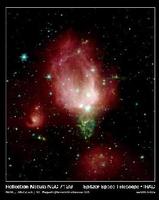 A couple of cool astronomical finds in the last couple of days. First one you can see on the left in a picture from the Spitzer Space Telescope. It is a cluster of newborn stars called NGC 7129, 3300 lightyears away in the constellation Cepheus. The nebulosity is rose-colored and rosebud-shaped. And all these stars are found in a piece of space about the same size as the distance between the Sun and the nearest star to here, Proxima Centauri. A couple of cool astronomical finds in the last couple of days. First one you can see on the left in a picture from the Spitzer Space Telescope. It is a cluster of newborn stars called NGC 7129, 3300 lightyears away in the constellation Cepheus. The nebulosity is rose-colored and rosebud-shaped. And all these stars are found in a piece of space about the same size as the distance between the Sun and the nearest star to here, Proxima Centauri.
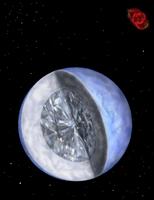 What you see on the right is not a photo. But what it depicts is rather amazing. It is a crystallized white dwarf named BPM 37093. A white dwarf is the hot core of a star, left over after the star uses up its nuclear fuel and dies. It is made mostly of carbon and is coated by a thin layer of hydrogen and helium gases. And in this case it has now been found that the core of this star is solid diamond. It is 2,500 miles across and weighs 5 million trillion trillion pounds, which translates to approximately 10 billion trillion trillion carats, if you want to measure it as an earth diamond. Supposedly our sun will end its days as a diamond as well. What you see on the right is not a photo. But what it depicts is rather amazing. It is a crystallized white dwarf named BPM 37093. A white dwarf is the hot core of a star, left over after the star uses up its nuclear fuel and dies. It is made mostly of carbon and is coated by a thin layer of hydrogen and helium gases. And in this case it has now been found that the core of this star is solid diamond. It is 2,500 miles across and weighs 5 million trillion trillion pounds, which translates to approximately 10 billion trillion trillion carats, if you want to measure it as an earth diamond. Supposedly our sun will end its days as a diamond as well.
[ Science | 2004-02-14 18:42 | | PermaLink ] More >
|
|
| Saturday, January 31, 2004 |  |
|
|
|
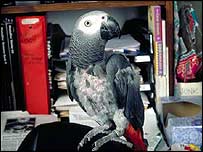 Here's the story of a rather stunningly capable parrot. Here's the story of a rather stunningly capable parrot.The finding of a parrot with an almost unparalleled power to communicate with people has brought scientists up short.
The bird, a captive African grey called N'kisi, has a vocabulary of 950 words, and shows signs of a sense of humour.
He invents his own words and phrases if he is confronted with novel ideas with which his existing repertoire cannot cope - just as a human child would do.
N'kisi's remarkable abilities, which are said to include telepathy, feature in the latest BBC Wildlife Magazine.
N'kisi is believed to be one of the most advanced users of human language in the animal world.
About 100 words are needed for half of all reading in English, so if N'kisi could read he would be able to cope with a wide range of material. He uses words in context, with past, present and future tenses, and uses humor. Are you sure that's really a parrot? If so, somebody has some explaining to do. The telepathy is particularly cool.
[ Science | 2004-01-31 17:49 | | PermaLink ] More >
|
|
| Sunday, January 25, 2004 |  |
|
|
|
 Ananova: Ananova:Russian scientists have been unable to disprove a teenage girl who claims she has x-ray vision and can see inside human bodies.
Doctors at Saransk's children hospital carried out exhaustive tests on 16-year-old Natalia Demkina whose claims she has x-ray vision has gripped the Russian public.
But so far they have been unable to come up with a logical explanation for the vivid and detailed accounts she gives of what she sees when she looks inside the human body. Eh, maybe the logical explanation is that she HAS x-ray vision.
[ Science | 2004-01-25 12:36 | | PermaLink ] More >
|
|
| Saturday, January 24, 2004 |  |
|
|
|
BBC Science:Scientists say that they have shown how the brain can crack complex mental puzzles while its owner is sleeping. Research at Luebeck university, in Germany, says tests on 106 volunteers back up anecdotal evidence that a good night's sleep can help solve problems. The volunteers were shown a number puzzle in which was embedded a "hidden code" revealing the answer, the journal Nature reports. Those kept awake overnight reportedly had far less chance of solving it. The scientists believe that because the brain appears to restructure information from the previous day during sleep hours, a period of sleep may produce insight into problems such as these. Other experts say it is the first hard evidence that creativity and problem-solving may be assisted by the activity of the brain during sleep. Dr Jan Born, who led the study, said: "This restructuring might be occurring in such a way that the problem is easier to solve." He highlighted a period of sleep called slow-wave sleep - a deep sleep not thought to be punctuated by dreams. Even small reductions in this sleep phase have been linked by other studies to a decrease in memory function, and in decreasing ability to recognise "hidden structures". Their 106 volunteers were all given a quick look at a test that involved sorting numbers based on a couple of set rules. However, underlying these rules was a third, "hidden" rule which, when spotted, dramatically simplified the completion of the puzzle. Some of the volunteers then got a full eight hours' sleep, while others had various degrees of sleep deprivation. The scientists then sat back to see which volunteers had a flash of inspiration and spotted the third rule and how quickly they managed it. Twice as many of the rested participants caught on to the rule than volunteers from the sleepless group. Shouldn't be too big a surprise, but I guess it is good to have "hard evidence".
[ Science | 2004-01-24 19:47 | | PermaLink ] More >
|
|
| Wednesday, January 21, 2004 |  |
|
|
|
 Ha, this is cool. Aerogel is a weird and wonderful material that looks like solid smoke and is the lightest solid substance we know. Only a little heavier than air. 0.003 grams per cubic centimeter. 1000 times less dense than glass. And it is made of 99.8% air. But yet it is the most efficient insulator we know, 39 times more insulating than the best fiberglass insulation. And it is very strong, able to carry 2,000 times its own weight without damage. And non-toxic. It was invented in the 1930s, but was largely forgotten until somebody at JPL in the 1980s needed a material that could gather comet particles that might be moving three to six miles per second, without destroying either them or the collector. Now it is being used frequently in space probes, and you can get arctic clothing that uses it as insulation. Articles: NY Times, SpaceDaily, and JPL has information and some cool pictures. And here's a company selling it. It is still very expensive, though. Ha, this is cool. Aerogel is a weird and wonderful material that looks like solid smoke and is the lightest solid substance we know. Only a little heavier than air. 0.003 grams per cubic centimeter. 1000 times less dense than glass. And it is made of 99.8% air. But yet it is the most efficient insulator we know, 39 times more insulating than the best fiberglass insulation. And it is very strong, able to carry 2,000 times its own weight without damage. And non-toxic. It was invented in the 1930s, but was largely forgotten until somebody at JPL in the 1980s needed a material that could gather comet particles that might be moving three to six miles per second, without destroying either them or the collector. Now it is being used frequently in space probes, and you can get arctic clothing that uses it as insulation. Articles: NY Times, SpaceDaily, and JPL has information and some cool pictures. And here's a company selling it. It is still very expensive, though.
[ Science | 2004-01-21 14:10 | | PermaLink ] More >
|
|
| Monday, January 19, 2004 |  |
|
|
|
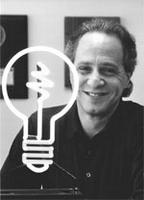 Ray Kurzweil on the nature of order, via SynEarth: Ray Kurzweil on the nature of order, via SynEarth:The concept of the "order" of information is important here, as it is not the same as the opposite of disorder. If disorder represents a random sequence of events, then the opposite of disorder should imply "not random." Information is a sequence of data that is meaningful in a process, such as the DNA code of an organism, or the bits in a computer program. Noise, on the other hand, is a random sequence. Neither noise nor information is predictable. Noise is inherently unpredictable, but carries no information. Information, however, is also unpredictable. If we can predict future data from past data, then that future data stops being information. We might consider an alternating pattern ("0101010. . . .") to be orderly, but it carries no information (beyond the first couple of bits). Thus orderliness does not constitute order because order requires information. However, order goes beyond mere information. A recording of radiation levels from space represents information, but if we double the size of this data file, we have increased the amount of data, but we have not achieved a deeper level of order. Order is information that fits a purpose. The measure of order is the measure of how well the information fits the purpose. In the evolution of life-forms, the purpose is to survive. In an evolutionary algorithm (a computer program that simulates evolution to solve a problem) applied to, say, investing in the stock market, the purpose is to make money. Simply having more information does not necessarily result in a better fit. A superior solution for a purpose may very well involve less data. The concept of "complexity" is often used to describe the nature of the information created by an evolutionary process. Complexity is a close fit to the concept of order that I am describing, but is also not sufficient. Sometimes, a deeper order—a better fit to a purpose—is achieved through simplification rather than further increases in complexity. For example, a new theory that ties together apparently disparate ideas into one broader more coherent theory reduces complexity but nonetheless may increase the "order for a purpose" that I am describing. Indeed, achieving simpler theories is a driving force in science. Evolution has shown, however, that the general trend towards greater order does generally result in greater complexity. Thus improving a solution to a problem—which may increase or decrease complexity—increases order. That's pretty profound. And obvious at the same time. Greater order, of the kind of evolving life and intelligence, typically means more complexity. But of course complexity by itself doesn't produce emergent order. Sometimes it does, and sometimes simplicity does the trick. The key is whether we get to the deeper level of order. Whether problems are being solved at a higher level.
[ Science | 2004-01-19 15:30 | | PermaLink ] More >
|
|
| Saturday, January 17, 2004 |  |
|
|
|
 George Bush announced the intent to put humans on Mars. Which is primarily a good distractionary move now that an election is coming up, and he doesn't have to figure out how to pay for it. Aside from that it is a fine idea. George Bush announced the intent to put humans on Mars. Which is primarily a good distractionary move now that an election is coming up, and he doesn't have to figure out how to pay for it. Aside from that it is a fine idea.
But with the kind of technology that is envisioned for the purpose it is very difficult. In part that is because the people who go there need to bring equipment and fuel for getting back again. And it takes a lot of fuel to take off from Mars. So, one alternative, but somewhat controversial idea would be that it initially would be a one-way ticket rather than a return ticket. Article here in NY Times (registration required). It is really not a problem finding volunteers. They need to bring enough equipment to survive and be able to start utilizing Martian resources. And every couple of years new supplies and volunteers can arrive. Until the colony becomes self-sufficient.
And (via Le Danois) somebody should maybe think a bit bigger and study this How-To for Terra-Forming. Mars is quite well suited for a large scale transformation into a green and lively planet. Which it might or might not have been in the past. Of course it would be sensible to thoroughly investigate what is already there, before re-formatting and re-booting the whole place.
[ Science | 2004-01-17 16:41 | 0 comments | PermaLink ]
|
|
| Wednesday, January 14, 2004 |  |
|
|
|
 The pictures from Mars are pretty damn cool. Particularly the 360 degree QTVR version. Just like being there, I suppose. Seems to be lots of things to explore. As far as red rocks go. One of the ones lying just in front of the lander looks almost artificially angled to me. Would be fun if they had landed on top of an old ruin. The pictures from Mars are pretty damn cool. Particularly the 360 degree QTVR version. Just like being there, I suppose. Seems to be lots of things to explore. As far as red rocks go. One of the ones lying just in front of the lander looks almost artificially angled to me. Would be fun if they had landed on top of an old ruin.
I'm a bit skeptical about Mars. Meaning, I'm not sure I believe this is the most advanced space program. Maybe the most advanced that NASA is carrying out, and hats off to this success for them. But my guess is that there are more hidden groups with considerably more advanced technology, and that they've already been there. And quite possibly made sure that the public program only lands in a place where there's nothing embarrassingly strange within sight.
[ Science | 2004-01-14 03:00 | | PermaLink ] More >
|
|
| Thursday, January 1, 2004 |  |
|
|
|
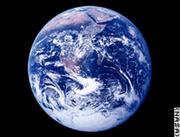 Apparently the Earth has unexpectedly speeded up a bit. Since 1955 when the atomic clock was invented, and time therefore could be measured more precisely, it became clear that each year doesn't have exactly the same length. Thus, in 1972 an extra "leap second" was added to each year, in order to make things fit. Because, presumably, the earth is slowly rotating slower and slower. It is just that, in the last five years, the earth is no longer rotating as slow as it was then, so the leap seconds don't seem to be needed. In other words, the earth speeded up a little bit, contrary to expecation. I'm glad she has a mind of her own. Apparently the Earth has unexpectedly speeded up a bit. Since 1955 when the atomic clock was invented, and time therefore could be measured more precisely, it became clear that each year doesn't have exactly the same length. Thus, in 1972 an extra "leap second" was added to each year, in order to make things fit. Because, presumably, the earth is slowly rotating slower and slower. It is just that, in the last five years, the earth is no longer rotating as slow as it was then, so the leap seconds don't seem to be needed. In other words, the earth speeded up a little bit, contrary to expecation. I'm glad she has a mind of her own.
[ Science | 2004-01-01 16:06 | | PermaLink ] More >
|
|
| Thursday, December 11, 2003 |  |
|
|
|
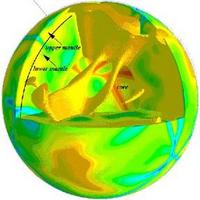 Roland Piquepaille mentions that geoscientists have captured images of the inside of the earth, through a process somewhat analogous to ultrasound scanning of a humanbody. Roland Piquepaille mentions that geoscientists have captured images of the inside of the earth, through a process somewhat analogous to ultrasound scanning of a humanbody. The scientists used tremors from earthquakes to probe the inside of the planet just as sound waves allow doctors to look inside a mother's. The technique, a greatly refined version of earlier efforts, produced a surprisingly sharp image and yielded the first direct measurements of giant spouts of heat, called mantle plumes, that emanate from deep within the planet.
Mantle plumes are believed to cause island chains, such as the Hawaiian Islands and Iceland, when the Earth's crust passes over the column of heat. Although accepted by most scientists, the existence of mantle plumes has been fiercely contested by a minority of researchers in recent years. Hm, would be cool if it were live.
[ Science | 2003-12-11 16:12 | 0 comments | PermaLink ]
|
|
| Monday, December 1, 2003 |  |
|
|
|
New Scientist reports that a small British company, TriStem, seems to have found a way of turning human white blood cells into a "stem-cell-like" state, which then allows them to be used by the body to repair and rebuild all sorts of problems in the human body. Which, if true, would create a revolution in the field of medicine. Traditional scientists are sceptical, because the research hasn't been presented through the normal channels, and the people in charge of it don't have quite the right credentials.
[ Science | 2003-12-01 15:27 | | PermaLink ] More >
|
|
| Friday, November 21, 2003 |  |
|
|
|
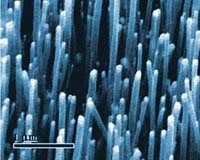 Nano technology progresses on various fronts. Nano technology progresses on various fronts.
According to New Scientist, Israeli researchers have succeeded in getting DNA to assemble nano-scale transistors. In other words, biology used to create self-assembling electronic devices. Still way to go before it can be useful, but it is the first successful demonstraton of that kind.
And, according to SpaceDaily, Russian scientists have made a device that should be able to produce large amounts of nanotubes. Carbon nanotubes is the strongest material currently in existence. It is a key component of plans to create space elevators. E.g. cables from the earth to geo-stationary orbit, allowing you to take an elevator into orbit. Or, better yet, cables from the earth to the moon.
[ Science | 2003-11-21 15:15 | | PermaLink ] More >
|
|
| Monday, November 3, 2003 |  |
|
|
|
I don't really understand a word of this article in Scientific American. But it seems that a reknowned theoretical physicist is suggesting that the universe is a 3-4 dimensional hologram created from a 2 dimensional array of information. In part because, surprisingly, a 2D surface can contain more information than a 3D construct, as the latter would collapse by its own mass into a black hole at some point. Which is all certainly an intriguing idea. You know, a hologram is created by shining light on a special piece of film, and a 3D picture is created. So, as to the universe, it would mean that what we see and walk around in is an illusion generated from light and information. Which of course makes it seem kind of likely that we can generate something a little or a lot different by changing the information a bit.
[ Science | 2003-11-03 13:27 | | PermaLink ] More >
|
|
| Friday, October 17, 2003 |  |
|
|
|
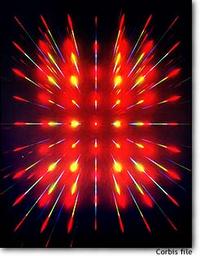 Researchers have shown than they can slow down light to a stand still, and even store its properties in atoms and then reconstitute the light later. And now other researchers have found that they can manufacture crystal that either slow down or speed up light. Researchers have shown than they can slow down light to a stand still, and even store its properties in atoms and then reconstitute the light later. And now other researchers have found that they can manufacture crystal that either slow down or speed up light.
It all reminds me of a science fiction story I read once where somebody had manufactured "slow glass". It would take something like 20 years for light to pass through a pane of glass like that. So, you would buy glass panes that had been standing around on the African savannah or in the Himalayas or something for years, and put them as windows in your house. And then, for years, you could look out at exotic wildlife walking about outside or breathtaking mountain views.
[ Science | 2003-10-17 10:55 | | PermaLink ] More >
|
|
| Thursday, June 19, 2003 |  |
|
|
|
 Via mamamusings, this overview of multiple dimensions by Elouise Oyzon, meant for discusion on a radio show. Those are the same models described in the article I mentioned here, but presented more simply. Via mamamusings, this overview of multiple dimensions by Elouise Oyzon, meant for discusion on a radio show. Those are the same models described in the article I mentioned here, but presented more simply.Suppose we start with the simple assumption that space and time are infinite.
Given some unlikely event- say that the proverbial roomful of monkeys banging away at a typewriter have a slim chance of typing out Romeo and Juliet…still with all of that infinite space and time in which to bang, it could happen. In fact, it does happen.
Slim chances are still chances.
Given all the time and space in the universe, a million to one shot will eventually shoot.
This is the basis for multiple dimensions. There are, in fact, 4 different flavors of multiple dimensions.
Flavor one: Scientists have theorized that somewhere, in this physical universe, out there is an earth just like this one, surrounded by eight planets, just like this one, and that on it is a you, just like this one. But that you may at this moment be turning off the radio and opting to do something else, while you, curious creature that you are, await the end of this story.
The reason you don’t see this parallel universe, is that it’s tremendously far away. There are millions of permutations, each far far away. So the chances of you running into your doppelganger is nil. (But then again, what did we say about chances?)
That’s flavor 1 – infinite space, parallel universes all in one.
Flavor 2 – has infinite space and infinitely varied time, and perhaps changeable physics. This theory says, okay, Bang! The universe begins to expand. But like eddys in water, there might be hot and cold spots. If the universe all expanded uniformly, time/space has a shot at uniformity too…but with this notion of eddys- actually “postinflation bubbles’, time would behave differently. (Remember discussions about the speed of light and relative time- well there you go!) In these bubbles, the initial conditions of the parallel universes, the very primordial soups, would be different. So not only do we have parallel universes, we have totally different pockets of alien physics. Maybe your doppelganger breathes methane and eats acid, has tentacles and does a mean eight-legged tango.
Flavor 3 – I do so want to explain this clearly to you, but I cannot because it assumes an understanding of quantum physics which I’ve been trying to wrap my head around now for 20 years. Shroedinger’s cat? The notion that thing are happening infinitely in the here and now, but that existence is based upon what you’ve observed, but that it does not necessarily connote the only reality – ow. It just hurts. It makes my head hurt. So that said- flavor 3, multidimensions, right here. Same spatial plane somewhere you can’t see. There. Listen to Adam Frank- he’ll explain it better.
Flavor 4 is entirely theoretical. We live in a world of 4 dimensions- the three dimensions of x, y, and z to locate position, and the fourth dimension of time. That can be represented mathematically. Some scientists posit that any mathematical formula represents some reality. Infinite variations on formulas suggest multiple dimensions beyond our puny 4 dimensional imaginings.
So there are Multiple dimensions.--lots of them.
I’d like think that in some alternate dimension, during my sophomore year of high school, I’d had a clue that Mike Simpson had asked me on a date – and that alternate me went. Or that several other times in the sad and promiscuous 80’s I’d said “no” more often to several other guys- and you can guess who you are.
It is an intriguing notion.
Still, My hope is that there are many different varied happy endings for us all.
[ Science | 2003-06-19 22:48 | | PermaLink ] More >
|
|
| Monday, June 2, 2003 |  |
|
|
|
Via SynEarthNews, from Wired:The methods of manufacturing and compressing hydrogen gas require great amounts of energy. To overcome these challenges, scientists have been tinkering with the biological powers of everything from common yeast to mysterious bacteria living on the ocean floor. At the University of California at Berkeley, mechanical engineering professor Liwei Lin is busy developing a microbial fuel cell that runs off the digestive activity of baker's yeast. The yeast feed on glucose, a simple sugar, and digest it in a process called aerobic metabolism. "We extract electrons from the yeast cells where the aerobic metabolism process happens," Lin explains. Controlling the movement of electrons to harness a renewable source of fuel remains the target for scientists designing fuel cells, which extract power from electrochemical reactions. The advantage of Lin's mechanism is that it runs on glucose, a naturally abundant resource produced by plants.
[ Science | 2003-06-02 16:35 | | PermaLink ] More >
|
|
| Tuesday, May 27, 2003 |  |
|
|
|
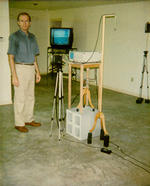 Via mysterious earth, this announcement from a physics researcher who says he's come up with the equation for demonstrating telekinesis: Via mysterious earth, this announcement from a physics researcher who says he's come up with the equation for demonstrating telekinesis:TK = CFe + ZPE - SD - E+ It means that Telekinesis (TK) is the result of a sufficiently high amount of Iron in the brain (CFe), of a Zero Point Emotion (ZPE) state, not using energy on will power or imagination or anything, and it is reduced by any degree of Sleep Deprivation (SD), and reduced by any degree of excesss vitamin E (E+) as that reduces the iron.
Eh, hm, that's a bit silly, I think. Doesn't exactly translate into something I can easily use, although maybe he's right about those points. But I don't think we can consider that a scientific formula.
I'm all for telekinesis, and I've bent spoons, and done a couple of other "impossible" feats, like opening security locks with the wrong key. None of which I can easily repeat, but I do have a sense of the elements involved. Which is mostly a certain mental state which it isn't easy to create at will. Doing it with a group of people who create a common agreement that it is now possible - that helps. And some phenomenon of letting go and not investing any emotions or thoughts on the idea of failure.
[ Science | 2003-05-27 14:49 | | PermaLink ] More >
|
|
| Monday, May 5, 2003 |  |
|
|
|
Raymond Powers mentioned an article from Discover about a machine that apparently can turn a wide range of waste products into oil. Such as, for example, 600 million tons of turkey guts and other waste turning into 4 billion barrels of oil.Pardon me, says a reporter, shivering in the frigid dawn, but that sounds too good to be true.
"Everybody says that," says Appel. He is a tall, affable entrepreneur who has assembled a team of scientists, former government leaders, and deep-pocketed investors to develop and sell what he calls the thermal depolymerization process, or TDP. The process is designed to handle almost any waste product imaginable, including turkey offal, tires, plastic bottles, harbor-dredged muck, old computers, municipal garbage, cornstalks, paper-pulp effluent, infectious medical waste, oil-refinery residues, even biological weapons such as anthrax spores. According to Appel, waste goes in one end and comes out the other as three products, all valuable and environmentally benign: high-quality oil, clean-burning gas, and purified minerals that can be used as fuels, fertilizers, or specialty chemicals for manufacturing.
Unlike other solid-to-liquid-fuel processes such as cornstarch into ethanol, this one will accept almost any carbon-based feedstock. If a 175-pound man fell into one end, he would come out the other end as 38 pounds of oil, 7 pounds of gas, and 7 pounds of minerals, as well as 123 pounds of sterilized water. Ah, I always knew I'd be good for something.
[ Science | 2003-05-05 23:01 | | PermaLink ] More >
|
|
<< Newer stories Page: 1 2 3 4 Older stories >> |

